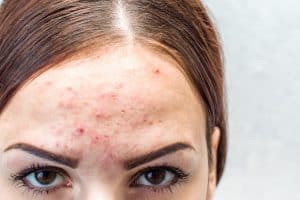While admiring yourself in front of your mirror, you notice something similar to blackheads or whiteheads on your skin. They even ooze or pop out as you squeeze them, but in reality, they are neither blackheads nor whiteheads. So, what are they? These are known as sebaceous filaments. There’s no need to be worried as everyone has them, but sometimes they are more prominent, making them noticeable. Continue reading to know what exactly they are, causes and how to prevent them.
What Does Sebaceous Filaments Mean?
Beneath your skin’s surface are tiny glands that produce sebum (oil). As the body produces extra sebum, it leads to sebaceous filaments filling up. Sebaceous filament comprises dead skin cells and sebum that collects around your hair follicles.
In simple terms, sebaceous filaments are tiny collections of sebum that are part of the pore structure. You may usually find them around your chin and nose.
Do Sebaceous Filaments Become Blackheads?
As the pores continue to fill, the sebum gets exposed to air and eventually turns black or into a blackhead. It can also lead to other forms of acne such as whiteheads, pustules and papules.
What Happens if You Squeeze the Pores on Your Chin or Nose?
It may make you happy for a short while, but in the long run, you’ll be harming your skin in the following way.
- Enlarged pores
- Possibility of infection
- Bacteria may spread to other areas
- Skin tissue damage
How are Blackheads and Sebaceous Filaments Different?
- A blackhead is extremely dark in colour. It occurs when the blockage gets oxidised as it comes in contact with air. Whereas sebaceous filament that looks similar to a dark dot may be grey, yellow or clear.
- A white or yellow string-like structure may ooze out when you extract/squeeze a sebaceous filament. On the other hand, removing your blackhead may bring out the dark stuff. Underneath, you can find skin cells and yellow or white sebum.
What Causes Sebaceous Filaments?
They naturally occur in your pores but become an issue once they are noticeable. Though, some people are more prone to clogged filaments as compared to others. Some of the potential causes can be hormonal imbalances, oily skin, genetics and family history.
How Can You Prevent or Minimise Sebaceous Filaments?
Maintaining good hygiene can be beneficial and a great starting point. The key is to strike the right balance between oil and moisture on your skin.
Here are some tips shared by AAD that you can incorporate into your skincare routine.
- Be careful while buying skin care products. Look for terms such as unclogs pores, oil-free, non-comedogenic and non-acnegenic.
- Avoid washing your face frequently, and stick to washing it twice a day.
- Choose a mild face wash or cleanser ideal for your skin type.
- Be gentle with your skin, and better avoid scrubbing.
- Do not skip moisturising your skin every day.
- Use a mask that aids in deep cleaning your pores.
- Regularly exfoliate your skin. Remember to use an exfoliant that is mild and won’t harm your skin.
Talk to a Dermatologist
You can discuss with your doctor the skincare products suitable for you and things you need to avoid. At times, they can also recommend treatments such as microdermabrasion and chemical peels.
Summing Up
There is no need to be worried if you notice sebaceous filaments. It’s normal, and all of us have them. The problem arises as it becomes visible. Follow a good skincare routine and the right products to make things easier. If you are unable to see results despite trying a lot or have some queries, reach out to a dermatologist.
FAQs
- Is there a way to get rid of sebaceous filaments?
No, you cannot get rid of sebaceous filaments as they are part of your skin. Though, you can minimise their appearance.
2. Can one use baking soda to reduce pore size?
There is no medical evidence claiming that this will help. It is always better to plan effective treatment options and your doctor rather than experimenting with your skin.
3. Is tea tree oil a good treatment option for sebaceous filaments?
There is no medical evidence to prove that tea tree oil is a good option to treat sebaceous filaments.
4. Are pore vacuums helpful, and do dermatologists recommend them?
You may come across pore vacuums in the market, and some may be helpful too. However, it is always best to first check with your doctor whether they will benefit you or not.




